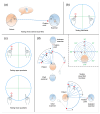Sensitivity and Specificity of Qualitative Visual Field Tests for Screening Visual Hemifield Deficits in Right-Brain-Damaged Stroke Patients
- PMID: 38539623
- PMCID: PMC10969102
- DOI: 10.3390/brainsci14030235
Sensitivity and Specificity of Qualitative Visual Field Tests for Screening Visual Hemifield Deficits in Right-Brain-Damaged Stroke Patients
Abstract
A timely detection of visual hemifield deficits (VHFDs; hemianopias or quadrantanopias) is critical for both the diagnosis and treatment of stroke patients. The present study determined the sensitivity and specificity of four qualitative visual field tests, including face description, confrontation tests (finger wiggle), and kinetic boundary perimetry, to screen large and dense VHFDs in right-brain-damaged (RBD) stroke patients. Previously, the accuracy of qualitative visual field tests was examined in unselected samples of patients with heterogeneous aetiology, in which stroke patients represented a very small fraction. Building upon existing tests, we introduced some procedural ameliorations (incl. a novel procedure for kinetic boundary perimetry) and provided a scoresheet to facilitate the grading. The qualitative visual field tests' outcome of 67 consecutive RBD stroke patients was compared with the standard automated perimetry (SAP; i.e., reference standard) outcome to calculate sensitivity and specificity, as well as positive and negative predictive values (PPV and NPV), both for each individual test and their combinations. The face description test scored the lowest sensitivity and NPV, while the kinetic boundary perimetry scored the highest. No test returned false positives. Combining the monocular static finger wiggle test (by quadrants) and the kinetic boundary perimetry returned the highest sensitivity and specificity, in line with previous studies, but with higher accuracy (100% sensitivity and specificity). These findings indicate that the combination of these two tests is a valid approach with RBD stroke patients, prompting referral for a formal visual field examination, and representing a quick, easy-to-perform, and inexpensive tool for improving their care and prognosis.
Keywords: confrontation tests; hemianopia; kinetic boundary perimetry; quadrantanopia; right-brain stroke; sensitivity; specificity; visual field.
Conflict of interest statement
The authors declare no conflicts of interest.
Figures


References
-
- Jariyakosol S., Jaru-Ampornpan P., Manassakorn A., Itthipanichpong R., Hirunwiwatkul P., Tantisevi V., Somkijrungroj T., Rojanapongpun P. Sensitivity and specificity of new visual field screening software for diagnosing hemianopia. Eye Brain. 2021;13:231–238. doi: 10.2147/EB.S315403. - DOI - PMC - PubMed
-
- Rowe F.J., Wright D., Brand D., Jackson C., Harrison S., Maan T., Scott C., Vogwell L., Peel S., Akerman N., et al. A prospective profile of visual field loss following stroke: Prevalence, type, rehabilitation, and outcome. Biomed. Res. Int. 2013;2013:719096. doi: 10.1155/2013/719096. - DOI - PMC - PubMed
LinkOut - more resources
Full Text Sources
Miscellaneous

